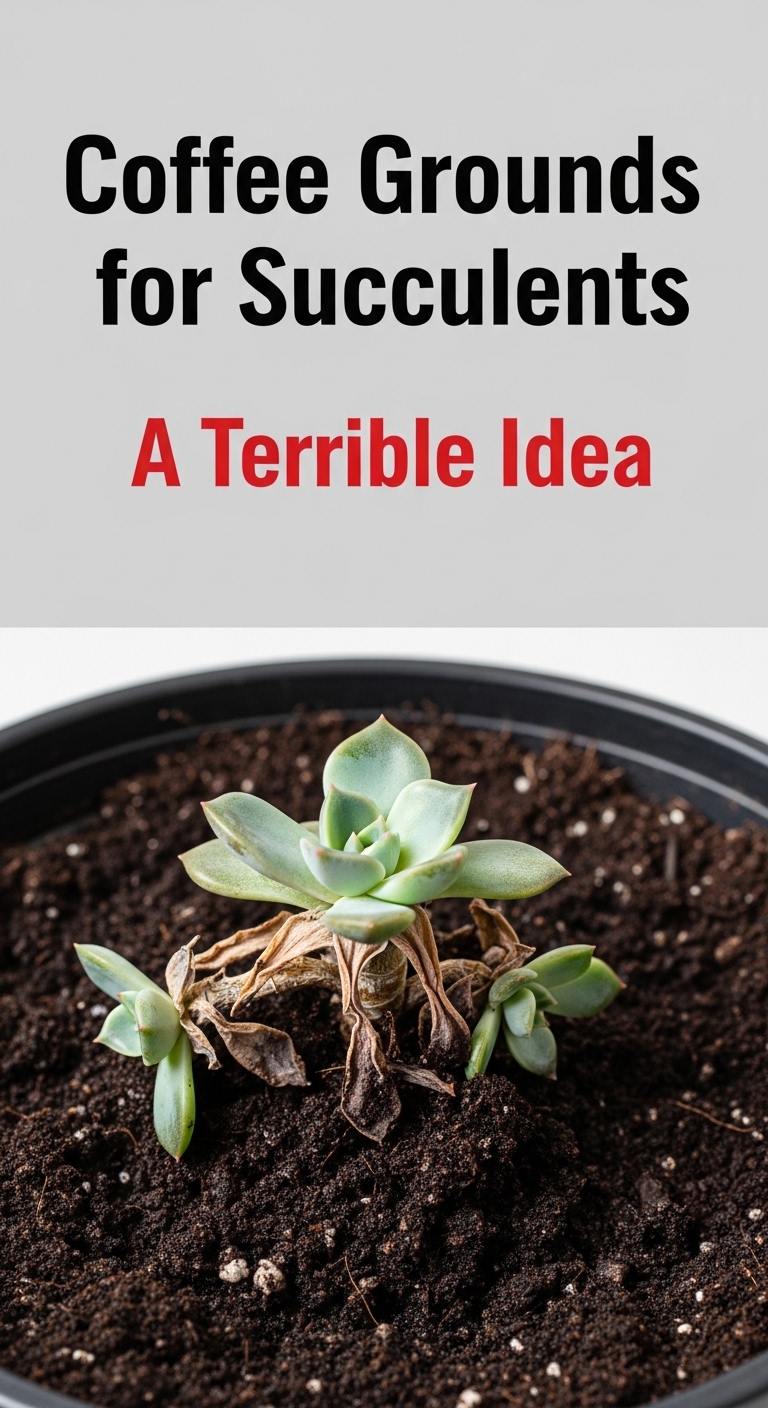As an Amazon Associate CoffeeXplore.com earns from qualifying purchases.
Coffee Grounds for Succulents: A Terrible Idea
Thinking of sprinkling your leftover morning coffee on your succulents? It’s a popular garden “tips” you’ve probably seen online, promising a free and easy nutrient boost. But you’re right to be skeptical. You want to help your plants thrive, not accidentally harm them with well-intentioned but misguided advice.
No, using used coffee grounds directly on succulents is a terrible idea. The grounds retain excessive moisture which leads to fatal root rot, can cause nutrient burn from too much nitrogen, and create a breeding ground for mold and pests that harm the plant.
This guide will definitively settle the debate, using established horticultural principles and data. We’ll break down the science behind why this pairing doesn’t work, detail the major risks involved, and—most importantly—show you the only safe ways to use coffee grounds for your plants. We’ll even provide a step-by-step emergency plan if you’ve already made this common mistake.
Key Facts
- Moisture is the Enemy: Succulents are desert plants that demand well-draining soil. Data from multiple horticultural sources confirms that coffee grounds compact and retain excessive moisture, directly leading to root rot, the primary killer of succulents.
- A Suffocating Crust: When applied to the soil surface, used coffee grounds can form a dense, water-repellent crust. This barrier prevents water from reaching the roots and suffocates the soil, hindering aeration.
- Nutrient Overload: Succulents are low-feeders. While coffee grounds contain about 2% nitrogen, this is often too much for them, leading to weak, “leggy” growth (etiolation) and potential root burn, as highlighted by numerous plant care guides.
- Composting is the Gold Standard: The only expert-recommended method for using coffee grounds near succulents is to first break them down in a compost pile. To maintain a healthy compost balance, coffee grounds should constitute no more than 10-20% of the total volume.
- Acidity is a Misconception: While fresh coffee grounds are acidic, used (brewed) grounds are nearly pH neutral (6.5-6.8). The real danger isn’t the pH; it’s the catastrophic effect on soil structure and water retention.
The Verdict: Why Direct Coffee Grounds are a Terrible Idea for Succulents

Let’s cut right to the chase. The final answer, backed by a consensus from horticultural best practices, is a resounding no.
No, using coffee grounds directly on succulents is not recommended. The grounds retain excessive moisture leading to root rot, can cause nutrient burn, and may encourage mold growth and pests.
Applying coffee grounds straight from your coffee maker onto your succulent soil is one of the fastest ways to create an unhealthy environment for a plant that thrives on neglect. The core reasons for this are simple and direct:
- Excessive Moisture Retention: Coffee grounds hold onto water, turning well-draining succulent soil into a soggy swamp.
- Nutrient Imbalance: They release too much nitrogen too quickly for these slow-growing, low-nutrient plants.
- Mold and Pests: Damp, organic material is an open invitation for fungus, mold, and soil pests to move in.
So why is this popular ‘garden tips’ so risky for the very plants we’re trying to help? Let’s break it down.
The Science: Understanding the Mismatch Between Succulents and Coffee
To understand why this combination fails, we need to look at the fundamental needs of a succulent versus the properties of coffee grounds. Succulents thrive in nutrient-poor, well-draining soil, while coffee grounds introduce excess nitrogen and retain moisture, creating an environment directly opposed to the plant’s natural habitat.
Think of it like giving a desert lizard a rainforest habitat – the fundamentals are simply incompatible.
Here’s a clear, side-by-side comparison based on data from plant science resources:
| Characteristic | Succulent Preference | Coffee Ground Effect |
|---|---|---|
| Water Level | Dry, arid soil with excellent drainage | Retains high levels of moisture, compacts easily |
| Nutrient Needs | Very low; thrives in nutrient-poor soil | High in nitrogen (~2%), can cause nutrient burn |
| Soil Aeration | Needs “breathing room” for roots | Forms a dense, suffocating crust on the surface |
| Soil pH | Prefers slightly acidic to neutral (5.8-7.0) | Used grounds are near-neutral (pH 6.5-6.8) |
| Organic Matter | Prefers a high mineral content (pumice, perlite) | Adds dense, water-logging organic matter |
As you can see, while the pH of used grounds isn’t the main issue, every other property works directly against what a succulent needs to survive and thrive.
4 Major Risks of Using Coffee Grounds Directly on Your Succulents
Moving beyond the theory, applying coffee grounds directly to your succulent’s pot introduces four significant, practical risks. These issues can quickly turn a healthy plant into a struggling or dying one. The primary risks are severe moisture retention leading to fatal root rot, mold growth, nutrient burn from excess nitrogen causing weak growth, and attracting pests.
- Guaranteed Moisture Trap & Root Rot
This is the number one danger. Succulents have evolved to survive drought by storing water in their leaves. Their root systems are not equipped to sit in damp soil. According to multiple horticultural sources, coffee grounds are fine and dense, and they clump together when wet. This creates a sludgy layer in the soil that prevents water from draining away, leading to the dreaded, and often fatal, condition of root rot. -
Invitation to Mold and Fungus
Damp, dark, organic material is the perfect breeding ground for mold and fungus. Sprinkling coffee grounds on your soil surface creates exactly this environment. You may soon notice a layer of white or green fuzzy mold, which is not only unsightly but also signifies an unhealthy, overly-moist soil environment that can harm your plant.

- Nutrient Burn and Weak, Leggy Growth
Succulents are light feeders. Coffee grounds are rich in nitrogen, a nutrient that promotes leafy growth. When a succulent gets too much nitrogen, it can lead to two problems. First, it can “burn” the delicate roots. Second, it can cause etiolation—weak, pale, and stretched-out growth as the plant grows too fast without enough light to support it. This results in an unhealthy, unattractive plant.Quick Fact: Used coffee grounds can form a dense, water-blocking crust on top of soil, effectively suffocating the roots below.
-
Attracting Unwanted Pests
The rich organic matter in decomposing coffee grounds is a feast for pests like fungus gnats. These small flies lay their eggs in damp soil, and their larvae can feed on your succulent’s tender roots, causing significant damage over time.
The Only Safe Ways to Use Coffee Grounds for Succulents (With Caution)
After all those warnings, you might think coffee grounds are destined for the trash. But that’s not entirely true. If you are determined to recycle your grounds for your garden, there are safe ways to do it, but they require proper preparation. The safest methods involve first composting the grounds with other organic material or creating a highly diluted “coffee tea” to use as a liquid fertilizer sparingly.
Pro Tip: Always use brewed and dried coffee grounds for these methods. Fresh grounds are too acidic and contain caffeine that can harm your plants.
Method 1: In Compost (The Gold Standard)
This is by far the best and most recommended method. Composting allows the coffee grounds to break down completely, mitigating all the risks of direct application.
Why it’s safer:
* Neutralizes Risks: The composting process breaks down the dense structure of the grounds, eliminating moisture retention and compaction issues.
* Balances Nutrients: The nitrogen in the coffee grounds becomes part of a balanced, slow-release nutrient profile within the finished compost.
* Improves Soil: Finished compost is a fantastic soil conditioner, but it should still be used sparingly with succulents.
How-to:
1. Add to Compost Pile: Add your used coffee grounds to your compost bin or pile.
2. Maintain Ratio: As a rule of thumb provided by horticultural experts, coffee grounds should make up no more than 10-20% of the total compost material. Balance them with “brown” materials like dried leaves, cardboard, or sawdust.
3. Wait: Allow the compost to fully decompose over several months. It should be dark, crumbly, and smell earthy.
4. Amend Soil Sparingly: Once ready, you can mix a very small amount of this finished compost (e.g., 1 part compost to 10 parts succulent soil) into your potting mix when you repot your succulents.
Method 2: As a Diluted “Coffee Tea”
If you don’t have a compost pile, creating a weak liquid fertilizer is the next best option. This method provides a small nutrient boost without the risk of soil compaction or mold.
How-to:
1. Steep the Grounds: Place 1-2 cups of used coffee grounds into a 5-gallon bucket of water. Let it steep for 24-48 hours. This ratio comes from established gardening guides.
2. Strain Thoroughly: Pour the mixture through cheesecloth or a fine-mesh strainer to remove all solid coffee grounds. You only want the liquid. Discard the solids in your compost or trash.
3. Dilute Again: The resulting “coffee tea” is still too concentrated. Dilute it with an equal amount of plain water (a 1:1 ratio).
4. Water Sparingly: Use this diluted liquid to water your succulents. Do this no more than once every 4-6 weeks and only during their active growing season (spring and summer).
Help! I Already Put Coffee Grounds on My Succulents. What Now?
Don’t panic! If you’re reading this after already sprinkling grounds on your beloved plant, you’re not alone. It’s a common mistake. If you act quickly, you can prevent most of the potential damage. Here’s exactly what to do.
If you have already applied coffee grounds, immediately scrape off as much as you can. If the soil is wet, gently remove the plant, inspect the roots for rot, and repot into fresh, dry, well-draining succulent mix.
- Step 1: Immediately Scrape Off the Grounds. Use a spoon or your fingers to gently remove every bit of the coffee ground layer from the surface of the soil. Be careful not to damage the base of the plant or its shallow roots.
-
Step 2: Assess the Soil’s Moisture. Touch the soil. Is it soggy and waterlogged? If you just watered after applying the grounds, the risk of root rot is high.
-
Step 3: Repot if Necessary. If the soil is very wet, the safest bet is to repot the plant. Gently remove the succulent from its pot, and shake off as much of the old, wet soil as possible.
-
Step 4: Inspect the Roots. While the plant is out of the pot, look at the roots. Healthy roots are typically white or light-colored and firm. Rotted roots will be black, mushy, and may have a foul smell. If you see any rotted sections, use clean, sharp scissors to trim them off.
-
Step 5: Plant in Fresh, Dry Soil. Repot your succulent in a fresh, completely dry, well-draining succulent or cactus mix. Make sure the new pot has a drainage hole.
-
Step 6: Wait to Water. Do not water the newly repotted succulent for at least a week. This allows any cut roots to callous over and heal, preventing further rot.
Superior & Safer Alternatives for Fertilizing Succulents
The truth is, you don’t need to risk using coffee grounds when there are far better and safer ways to provide your succulents with the nutrients they need. The focus should always be on providing excellent drainage first and foremost. Safer and more effective alternatives include using a balanced commercial succulent fertilizer, amending soil with gentle worm castings, or simply repotting every 1-2 years into a proper, well-draining potting mix.
- Specialized Succulent Fertilizer: This is the easiest and most reliable option. Look for a liquid fertilizer formulated specifically for cacti and succulents, often with a balanced NPK ratio like 10-10-10. Dilute it to half or quarter strength and use it only once or twice during the growing season.
- Worm Castings: This is a fantastic organic alternative. Worm castings are a gentle, natural fertilizer that won’t burn your plant’s roots. You can mix a small amount into your soil mix during repotting for a slow-release nutrient boost.
- A Proper Potting Mix: This is the most critical factor for succulent health, far more important than fertilizer. A great mix should be 50-70% mineral grit (like pumice, perlite, or coarse sand) and only 30-50% organic matter. Repotting your plant every 1-2 years into fresh mix often provides all the nutrients it needs.

To ensure your succulents get the best possible foundation for growth, investing in a high-quality potting mix and the right tools for repotting is essential. This simplifies care and directly prevents the most common problems, like root rot.
FAQs About Using Coffee Grounds on Succulents
What is the best homemade fertilizer for succulents?
The best homemade options are gentle ones that prioritize plant safety. While coffee grounds are risky, other options are much better.
* Worm Castings: Mixing a small amount of worm castings into the soil is a safe, effective, and natural choice.
* Compost Tea: If you have a compost pile, steeping finished compost in water creates a nutrient-rich tea that is gentle enough for succulents when used sparingly.
* Diluted Coffee Tea: A highly diluted and strained “coffee tea” can be used, but it should be a last resort and applied with extreme caution and infrequency.
What plants can you not put coffee grounds on?
Based on SERP data and horticultural principles, you should avoid using coffee grounds on any plants that are sensitive to excess moisture or prefer alkaline soil.
* Plants that need dry soil: This includes all succulents and cacti, which are highly susceptible to root rot in moist conditions.
* Plants that prefer alkaline soil: Used coffee grounds are near-neutral, but fresh grounds are acidic. Avoid using them on plants like lavender, rosemary, asparagus, and beets that thrive in more alkaline conditions.
Do cactus or snake plants like coffee grounds?
No. Like succulents, both cacti and snake plants are highly susceptible to root rot and should not have coffee grounds applied directly to their soil due to moisture retention issues. These plants are extremely drought-tolerant and thrive in conditions that mimic their arid native habitats. Adding water-retaining coffee grounds is directly counterproductive to their needs.
What about using eggshells on succulents?
Crushed eggshells can add calcium to the soil over time as they slowly break down. However, they are not a complete fertilizer and do not provide the range of nutrients a plant needs. They don’t pose the same moisture risk as coffee grounds, which makes them safer, but they should only be considered a minor soil amendment, not a primary nutrient source. Your focus should always be on a high-quality, well-draining potting mix first.
Final Summary: Skip the Coffee, Feed Your Succulents Safely
While the idea of using a free household waste product to fertilize plants is appealing, the science and practical evidence are clear: direct application of used coffee grounds is a dangerous practice for succulents. The risk of moisture retention, root rot, mold, and pests far outweighs any potential benefit.
To ensure your succulents live long, healthy lives, it’s best to stick to proven methods.
* The Problem: Coffee grounds create a dense, waterlogged soil environment that is the exact opposite of what succulents need.
* The Safe Method: The only truly safe way is to first break them down in a compost pile before adding a small amount of the finished compost to your soil mix.
* The Best Path: Prioritize a high-quality, fast-draining potting mix and use a balanced, diluted succulent fertilizer once or twice a year if needed.
Now you have the facts. Protect your succulents by choosing the right care methods over popular but risky ‘tipss’. Healthy, beautiful plants are the result of understanding their fundamental needs, not of searching for shortcuts.
Last update on 2025-12-15 / Affiliate links / Images from Amazon Product Advertising API

